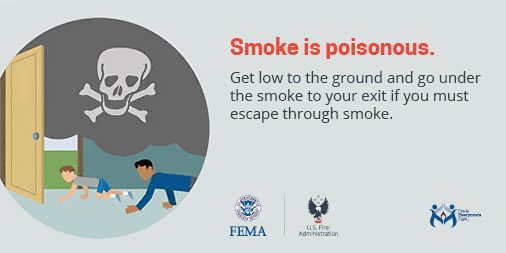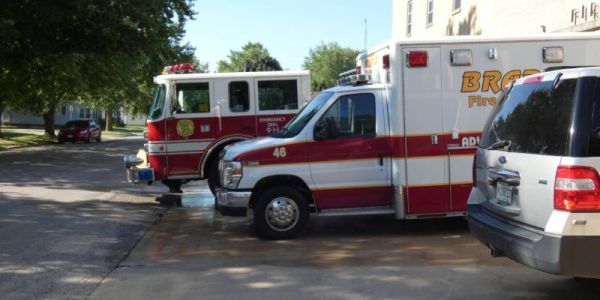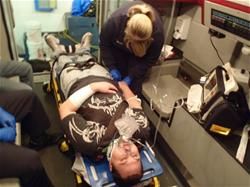Village of Bradley
Fire Safety
Did You Know?

Two-thirds of all home fire victims die of smoke inhalation, poisonous gases, or lack of oxygen; not severe burns.

More than 40% of fatal home cooking fires occur while the victim(s) are sleeping.

Careless use of smoking materials is the leading cause of residential fires that result in death.

Heating equipment is the second leading cause of residential fires.

Cooking is the leading cause of all residential fires and fire injuries.

Most fire fatalities and injuries in the US occur in the victim’s own home.
Contact Us
-
Ph: 815-933-2401
-
Fax: 815-933-0149
-
147 S. Michigan
Bradley, IL 60915
Station Services
Knox Box
A Knox Box is a small safe mounted to a building’s exterior with keys for use by the fire department during emergency services.
Smoke & CO Detector Information
Residential Requirements (All new and Existing Structures)
- A Smoke detector is required on the ceiling or wall outside of each sleeping area in the immediate vicinity of bedrooms (within 15′ of bedroom door(s)).
- A smoke detector is required in each room used for sleeping.
- A smoke detector is required in each story within a dwelling unit, including basements and cellars but not crawl spaces and uninhabitable attics. In dwellings with split levels and without an intervening door between the adjacent lower level provide that the lower level is less than one full story below the upper level.
- A CO detector is required within the immediate vicinity of bedrooms (within 15′).
Note: Existing newer constructed homes that may have more/extra detection devices installed as part of the fire detection system is to be maintained. The system is required to be fully operational at time of inspection.
Additional New Residential Construction Requirements:
Along with the above listed smoke detector devices and location requirements, new construction requires the following additional devices.
- A smoke detector is required at the top of each stairway. Regarding a basement stairway, the device may be relocated to the bottom, with fire department approval, when the top of the stairway location is near the kitchen facilities.
- A heat detector is required in any attached garages and shall be interconnected with smoke detectors.
- A heat detector is required in the utility areas where a washer and dryer are installed and shall be interconnected with smoke detectors.
Notes:
- All new and remodel construction requires devices (heat, smoke, & carbon monoxide detectors) to be supplied by a 120 volt circuit with battery back-up and shall be interconnected.
- Existing dwellings that currently do not have devices connected to 120 volts may continue to be powered by battery. If additional smoke detectors are required at inspection time, the additional devices are allowed to be installed with battery power.
Smoke & CO Detector Inspections
Smoke & CO Detector Inspections are available at request. Please call to schedule an inspection.
Inspection Times
8:00 am – 11:00 am
1:30 pm – 3:30 pm
Tuesday & Thursday
Call to Schedule
815-936-5112
Cost
$50.00 at time of inspection
Survival Tips
Fire Safety is all about preparedness. Utilize these tips to ensure that you and you family are safe in the event of a fire.
1.
Make sure your family has an escape plan.
2.
Sleep with the bedroom door closed. Closed doors provide protection against smoke and heat.
3.
Teach everyone in your household to recognize the sound of your smoke alarm.
4.
Test doors before opening them. You can easily be overcome by heat, smoke, or flames when you open a door to an area where a fire has spread.
5.
Use windows as alternate exits.
6.
Crawl low under smoke. During a fire, super heated air and toxic gases fill the room from the top down. This leaves a “safety zone” of breathable air about 12- 24 inches above the floor.

7.
Call 911. Unless you are trapped inside, it’s too dangerous to call from a burning home. Once you have escaped and reported to your meeting place, call 911 from a neighbor’s phone.
8.
If your clothes catch on fire:
- Stop, Drop gently to the ground and cover your face with your hands.
- Roll over and over or back and forth to put out the fire.
- Use cool water for 3 to 5 minutes to cool a burn.
- Get medical help right away.
Can you escape a house fire in two minutes?
Emergency Medical Services

Emergency Medical Services (EMS) is a huge part of the Bradley Fire Department. The Bradley Fire Department has one advanced life support (ALS) ambulances staffed 24 hours a day, seven days a week with six full time paramedics.
The department employs EMTs, paramedics, and field nurses. Paid on call EMS personnel respond to second ambulance calls and also assist with serious calls. The fire department averages 1500 EMS calls every year and the number increases with each year.
The ambulance responds to a variety of calls from chest pains to car accidents along with offering care and blood pressure screenings to the individuals that stop by the station and at community events.
Fire Suppression
Fire suppression is often the first thing that comes to mind when thinking of the Fire Department, but it is just a portion of what a department does. However, most firefighters will tell you it is the most challenging aspect of the job.
Fire suppression includes many categories such as structural, vehicular, brush, and industrial. Each category of fire suppression requires hours of training and preparation. Every fire-suppression incident is considered an emergency situation that can become very dangerous.
All scenes are managed by an incident command system. This system is an organized approach to handling emergency situations. The person in charge, called command, is responsible for every firefighter or EMS personnel on that scene. He or she makes sure the fire is correctly managed and that all personnel are safe while performing their duties.
Technical Rescue
Technical rescue is a term that describes special rescue scenarios. The Bradley Fire Department works with the Kankakee Valley Technical Rescue Team (KVTRT). The team responds to all “special rescue” situations and is made up of members from area fire departments.
These members volunteer their time for training and when on calls. Some of the special rescue situations include vertical rescue, trench collapse, confined space, and structural collapse rescues. All of these special situations require the KVTRT team members to train extensively.
Each member of the team is required to take classes in order to be a certified rescuer. Currently there are seven firefighters on Bradley Fire Department that are members of the KVTRT. With a recent FEMA grant, the Bradley Fire Department is now forming its own technical rescue team to improve response times in the village.
Emergency Vehicles Each EMS provider on the Bradley Fire Department has been formally trained through college accredited courses. There are two levels of EMS personnel hired by the Bradley Fire Department.
The first level is emergency medical technician basic (EMT-B). An EMT-B performs basic functions in the ambulance such as vital signs, bandaging, and assisting paramedics. This requires six months of classroom and practical training. The student then has to pass a state exam in order to function as an EMT.
The next level recognized by the Bradley Fire Department is paramedic. A paramedic performs more advanced medical care such as IVs, intubations, heart monitors, and medication administration. To become a paramedic is an extensive process.
The back of the ambulance. The paramedic program takes four college semesters to complete. Two semesters are spent in classroom and the last two semesters are practicals in the hospital and on the ambulance. At the end of the program the student then takes a states exam to be able to perform as a paramedic. A field nurse is a registered nurse that has been trained to function as a paramedic. Many hours go into training every year for all EMS personnel, so they can be ready for any call they might receive.

Insurance Services Officer
The Insurance Services Office (ISO) grading schedule is applied to many fire departments in most states approximately every 10 years. The purpose of the grading is to aid in calendaring fire insurance rates. It reviews and correlates features of public fire protection that have a significant effect on minimizing fire damage. Basically, the better the fire department the lower the number. In essence, the lower the rating, the lower the insurance rate–assuming the fire insurance company subscribes to the system. The Village of Bradley is rated 4 out of 10.
Specific questions regarding the schedule of rating can be directed to your insurance agent, broker, or the State Board of Insurance.
Public Education
The Bradley Fire Department has been involved in the community for more than 30 years doing school safety programs and other activities. The focus is on teaching about fire prevention and fire and life safety.
With a grant awarded to the Bradley Fire Department in 2003 through the Federal Emergency Management Association, a safety trailer simulating a smoky environment was purchased. It also teaches children about calling 9-1-1 and dangerous things found in every home.
Every fall and spring, the Bradley Fire Department brings the safety to Bradley East Elementary. Every class from preschool to second grade participates in the program. The safety trailer is also brought to many special events that take place throughout the year at different locations.
The Bradley Fire Department was also able to purchase a robotic dog named Freckles with the grant in 2003. Freckles travels with the safety trailer and also makes special appearances at the elementary schools.
Freckles’ specialty is teaching children about fire safety. There are many important things that Freckles talks to children about, but it is even more important for parents and guardians to talk to their children about fire safety.
Here are some important topics to cover with your children:
- Stop, drop, and roll when your clothes are on fire.
- When the smoke detector goes off, get out of the house and stay out.
- Crawl below the smoke while leaving the house.
- Don’t go back for pets or favorite toys.
- Meet family at a designated meeting place when you have to leave the house during a fire.
- If you get stuck in the house, do not hide from the firefighters.
- Change your smoke detector batteries twice a year during time changes.
- Never play with matches, candles, stoves, microwaves, fireplaces, and fireworks.
- When and how to call 9-1-1.
Remember to go over these simple tips to make you and your child safer.